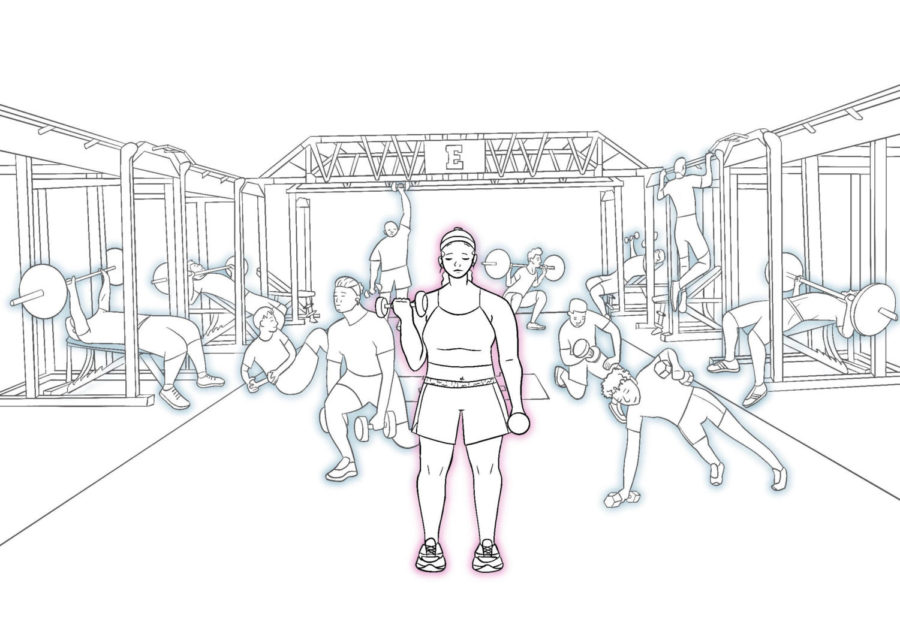Opinion | Gym culture isolates female-identifying students
March 15, 2023
At ETHS, there are two P.E. courses open primarily to juniors and seniors that take place in the weight room: Sport Specific Training (SST) and Strength and Conditioning.
If you were to walk into the weight room amidst either one of these classes and really looked, you would immediately notice the very uneven ratio of female to male students. It’s no secret that, for years, gym culture has been dominated by men, causing weight rooms to quickly become male-dominated areas that female-identifying individuals often feel unwelcome in. ETHS is known for its dedication to equity and inclusion, and so, it’s a problem that this imbalance persists.
In ETHS’ Student and Family Handbook, The Pilot, it’s declared that ETHS is “an inviting, welcoming place to learn that supports academic, social and emotional growth.” While ETHS does push its students and staff to promote diversity within the school, it’s apparent that in some spaces, diversity is lacking immensely.
ETHS’ students as well as the faculty that coordinate these classes in the weight room do not actively deny female-identifying students from weightlifting, but the main issue here is the uncertainty these female students may feel when joining these classes.
Junior Sophia Robles speaks on her experience as a female-identifying student in SST.
“At the beginning of my SST class, I was really uncomfortable. I had even mentioned switching classes at one point,” Robles says.
As someone who lifts outside of these classes, I can attest that this feeling of discomfort follows you everywhere—during classes in the weight room and even at the gym on your own time. By being at the gym almost daily, you’re practically forced to get used to the overwhelming amount of men surrounding you. There’s never a “correct” way of learning how to do so.
At the beginning of my SST class, I was really uncomfortable. I had even mentioned switching classes at one point.
— Junior Sophia Robles
Oftentimes, men will find any way possible to intimidate a woman in the gym. This can range from hovering over you so you can give up your bench, to simply acknowledging your presence, but actively ignoring you. Even outside of the SST and Strength and Conditioning classes, there’s always that feeling of uneasiness because this world still struggles to recognize that women are strong as well.
“I think a larger female population in class would make me more comfortable lifting,” Robles elaborates.
In an article published by USA Today titled, “Some women are sick of being harassed at gyms. Are women’s-only gyms fixing the problem?” social psychologist at the University of Connecticut, Diane Quinn, explains that gyms for women only provide peace of mind. “Feeling comfortable and safe while exercising is crucial, not only for your fitness journey but for your mental health,” Quinn elaborates.
Safety is not a concern at ETHS during classes in the weight room; what is a concern is the comfort of female students. As previously mentioned by Robles, a larger female population could be a possible solution to easing the nerves of some female-identifying students when new to weightlifting. To start, a simple resolution could include staffing female teachers to facilitate these classes. There’s nothing more inspiring and welcoming than a leadership figure who is just like you, shares the same interest as you, and pushes you to push yourself.
I’ve personally been weightlifting for over a year and, as previously stated, I’ve been forced to acclimate to the staggering amount of males in the gym. However, my partner in Strength and Conditioning was far from used to the disproportionate ratio of male students to female students in our class. I can recall numerous times when our conversations ended up discussing how many more male students there are in our class because, if you simply scanned the room, anyone would point out the same issue.
I will say, the male students in these classes are never bothered by female students wanting to weightlift. From my own knowledge, there have never been any cases in which male students have ridiculed any female students for taking a class in the weight room, but that’s not what I’m writing about.
ETHS and the faculty that run these classes need to recognize that what they’re currently doing is not considered wrong, but more just needs to be done to support female-identifying students. Faculty need to find ways to make these classes more welcoming to female students that may be scared to sign up, simply because they are aware of the population in these classes.
Another possible solution is simply creating all-female SST/strength and conditioning classes. ETHS already has all-female student classes, so this isn’t a difficult task. It’s simply a way to guarantee comfort amongst female-identifying students in possibly uncomfortable areas, like the weight room.
Though what was discussed throughout this article may come off as a way to favor female students in these sorts of classes, it’s certainly not. The purpose here was to advocate for the female students at ETHS either interested in taking SST/Strength and Conditioning classes or already taking them, but still feel uncertain about the lack of female students in their classes.
Issues like these are issues I wish were already solved and addressed. It’s an important topic that deserves attention as well as an issue that ETHS and its faculty need to find a resolution to. It’s been long overdue.




















